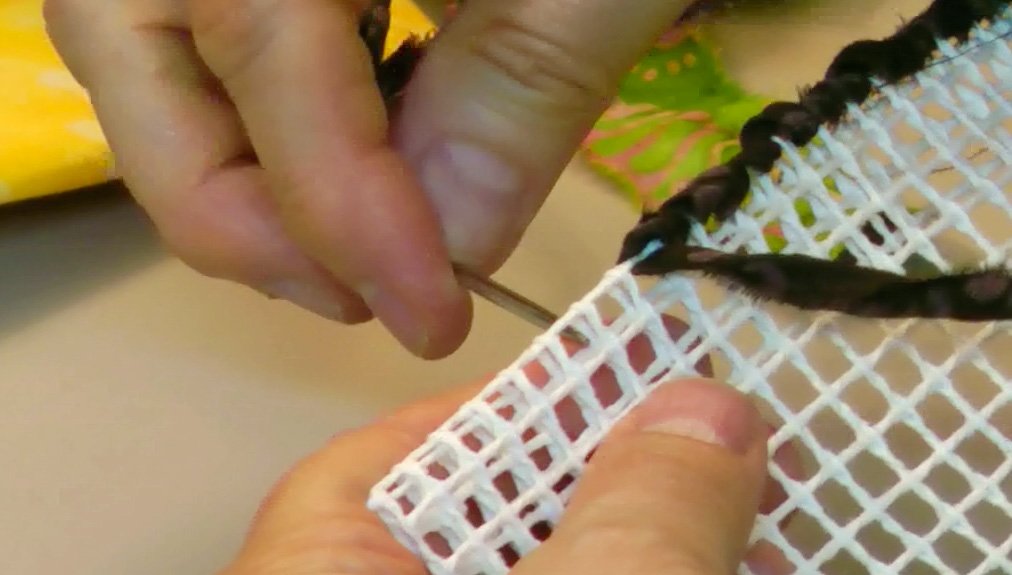Video Class:
With a special hook, fabric strips and some canvas, you’ll be creating beautiful projects in minutes. You won't believe how easy Locker Hooking is until you try it. Just click the Play button in the video below and I'll see you in class.
What you will Learn:
What is High Thread Count?
Locker Hooking works best with Batik fabrics because of the high thread count.
Why You Need a Finished Size Before Beginning
Before you even start Locker Hooking, you have to know where you're going. Buy Rug Canvas here.
Strip Widths
What strip widths are best for Locker Hooking? Use a 6x12 Rotary Ruler for quick marking. Get one here.
You Need a Jar Opener in the Sewing Room!
If you don't have a jar opener, you need one. It makes some things so much easier to do!
A Locker Hook is Both a Needle and a Hook.
Love this tool! You can get one here.
Class Supplies you will Need:
Rug Canvas
Locker Hook
Sewing Shears
Craft Scissor
Small Scissor
Tapestry Needle
Batik Fabrics
Tacky Glue
Small Clamps
Rotary Ruler (6x12)
Rubber Jar Opener
How To - Locker Hooking For Beginners:
Ever heard of Locker Hooking? If not, it’s probably not what you’re thinking it is!
Locker Hooking grew in popularity between 1920 and 1940 in Great Britain and America. In the 1920s, British craftswomen used heavy six-ply wool yarn to create durable rugs with a Locker Hooking process. In the 1940s Americans enjoyed Locker Hooking, too, but due to the high cost of the specialty yarn, the craft of Locker Hooking never seemed to become a widely embraced hobby.
In the early days women sometimes substituted strips of cotton fabric for the more costly strands of wool for Locker Hooked rugs which were quite similar in appearance to traditionally hooked rugs. Despite its practicality, Locker Hooking never really gained the popularity it deserved in America. Only recently has Locker Hooking been adopted as a wonderfully creative art form.
In traditional Locker Hooking, one pulls yarn through a canvas to form loops that are “locked” in place with another hidden strand of wool. A variety of stranded yarns have been used for Locker Hooking and even unspun wool which creates quite a unique look.
At first glance, you might mistake Locker Hooking as latch Hooking but actually they are quite different. The only thing they really have in common is the canvas. For latch Hooking, you need lots of pre-cut yarns along with a special latch hook to secure them to the canvas.
Locker Hooking requires a special needle hook that looks considerably more intimidating than it is to use. That’s where the fun begins! Don’t you love learning something that’s simpler to do than you imagined?
A great source for Locker Hooking ideas and inspiration can be found in needle work and cross stitching patterns. Simpler designs work best as reference for creating rugs, purses, coasters, ornaments, trivets, bracelets, book covers and a whole lot more.
The beauty of Locker Hooking is that you can use pre-designed patterns or you can simply draw a design on the canvas or you can create your own random use-it-up serendipity style. I like any kind of Locker Hooking as it’s relaxing and fun and grows quickly.
In class I’ll show you how to use fabric strips rather than yarn to create a colorful, luscious piece of Locker Hooking.
You’ll learn how to treat the canvas so it holds together properly, how to determine the size for your project, how to Locker Hook with fabric strips, how to finish your project, and you’ll see lots of cool ways to use Locker Hooking.
To join the class, just click the Play button in the video and you’re ready to enjoy a fun, creative and very rewarding needle art.
Class supplies include:
- Rug Canvas
- Locker hook
- Fabric Shears
- Craft Scissors
- Small Scissors
- Tapestry needle
- Batik Fabrics
- Tacky Glue
- Small clamps
- Rotary Ruler 6x12
- Rubber jar Opener
Download Class Notes:
Illustrated Tutorial
Download Illustrated Tutorial Class Notes for this video.
Text Only
Download Text Only Class Notes for this video.









